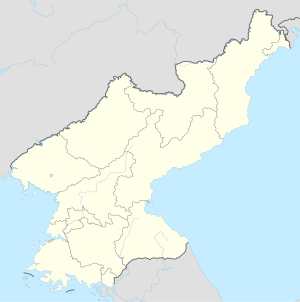Rajin
| Rajin-kuyŏk | |||
|---|---|---|---|
| Korean alphabet : | 라진 구역 | ||
| Chinese characters : | 羅 津 區域 | ||
| Revised Romanization : | Rajin-guyok | ||
| McCune-Reischauer : | Rachin-kuyŏk | ||
| Basic data | |||
| Province : | Hamgyŏng-pukto | ||
| Coordinates : | 42 ° 20 ' N , 130 ° 23' E | ||
| Residents: | 66,224 (as of 2005) | ||
| map | |||
|
|||
Rajin is a municipality in the city of Rason in North Korea with 66,224 inhabitants (2005). The municipality is located in the northeast of the Asian country on the coast of the Sea of Japan , only about 20 kilometers away from the Russian border. It formed the administrative center and was the largest city of the administrative unit Rajin-Sŏnbong, which was formed in 1993 and renamed Rasŏn and became a city in 2004.
History and meaning
Rasŏn, whose name is composed of “Rajin” and “ Sŏnbong ”, was until 2004 administratively a “city under central government administration” (like the capital Pyongyang ), but it was not a contiguous urban area, but was - with its relatively low population density and the dominant agricultural areas - more comparable to a small province.
Rajin is both an agricultural and industrial center with a port. The city district is the center of a free trade zone established in 1991 . Because of its geographical proximity to the People's Republic of China , the seaport of Rajin is an important container transshipment point. Docks 3 and 4 are operated by China and have been leased for 50 years. According to North Korean information, eight ships with 10,000 tons of displacement and an additional five ships with 5,000 tons of displacement can be handled at the same time. However, most of the goods handled are Chinese imports and exports and less North Korean trade.
The last major Russian investment in North Korea concerns the railway line from Russia to the ice-free port of Rajin. The Hongŭi Line connects the port of Rajin with the river Tumen located Chassan ; the river forms the border with Russian Siberia. The railway line has been renewed since the end of 2013. Both Russian broad-gauge and Korean standard-gauge trains can reach the port of Rajin, and the tracks have four rails .
Web links
- Sofia Dreisbach: Vacation in North Korea: “In the beginning I was scared”. Interview with Spiegel Online , September 7, 2017 (with photos)
Individual evidence
- ^ Aidan Foster-Carter: How North Korea was lost - to China . In: Asia Times Online , September 16, 2010, accessed September 7, 2017.
- ↑ North Korean Rail Link completed . In: Railway Gazette International , September 29, 2013, accessed on September 7, 2017 (with photo, English).



